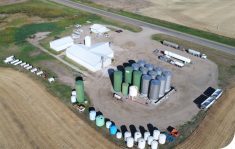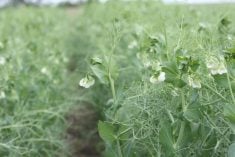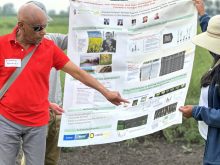Farmers are growing more canola, lentils, mustard, chickpeas and field peas in the brown and dark brown soil zones.
But compared with traditional cereals, these crops may increase the risk of soil erosion.
“The residue of these pulse and oilseed crops is more easily decomposed after tillage than cereal residue. On a pound for pound basis, furthermore, their residue is less effective for controlling erosion than cereal residue,” said Ken Panchuk, a soil specialist for Saskatchewan Agriculture.
Because of breakup during combining, these crops often produce less residue than cereals.
Read Also

Volunteers help exotic animal farm rebuild
Exotic animal farm loses beloved camel and pony to huge hail storm that gripped the Brooks, Alta. area as a community member starts a fundraiser to help the family recover from the financial and emotional damage.
Pulse residues also start decomposing sooner than cereal residue even when no tillage takes place.
A new report will help provide producers with specific information to help them manage field residue.
The report Environmentally Sustainable Production Practices for Diversified Cropping Systems in the Semiarid Prairie, was supported by the Canada Saskatchewan Agri-Food Innovation Fund.
The project was done at the Semiarid Prairie Agricultural Research Centre in Swift Current. It covers:
The amount of standing and flat residue left by canola, mustard, lentils, peas and chickpeas.
The effect of the tillage tool and speed on the conservation of both standing and flat residue from alternate crops.
The inherent erosion risk of Saskatchewan soils as indicated by soil aggregate characteristics.
An erosion risk calculation procedure that works for different crop residues and residue mixtures.
A spreadsheet program will help farmers estimate erosion risk and identify relevant options for managing that risk on their land base.
Project leader Brian McConkey said it should be available for downloading in early 2001.
A fact sheet called Securing Acceptable Erosion Risks after Pulses and Oilseeds in the Brown and Dark Brown Soil Zones will be available in early 2001. It has tables that show the residue amounts required to maintain acceptable levels of soil erosion risk for various crop types on different kinds of land.
Another table offers estimates of the remaining residue level for several crop sequences, yield levels and tillage management systems.
In general, pulses should be planted on land that is less prone to erosion. For example, if choosing between a field with shelterbelts and one without, choose the field with shelterbelts for the pulse crop.
Producers should also minimize or eliminate tillage after growing a pulse, canola or mustard crop in the brown and dark brown soil zone.
Farmers should also slow down. If seeding with sweeps, slowing from six to five miles per hour increases residue conservation by about 15 percent.
“Also, low-disturbance direct seeding greatly lowers the erosion risk by increasing the conservation of last year’s crop residue and by increasing the amount of residue carried over from previous crops,” said McConkey.
















